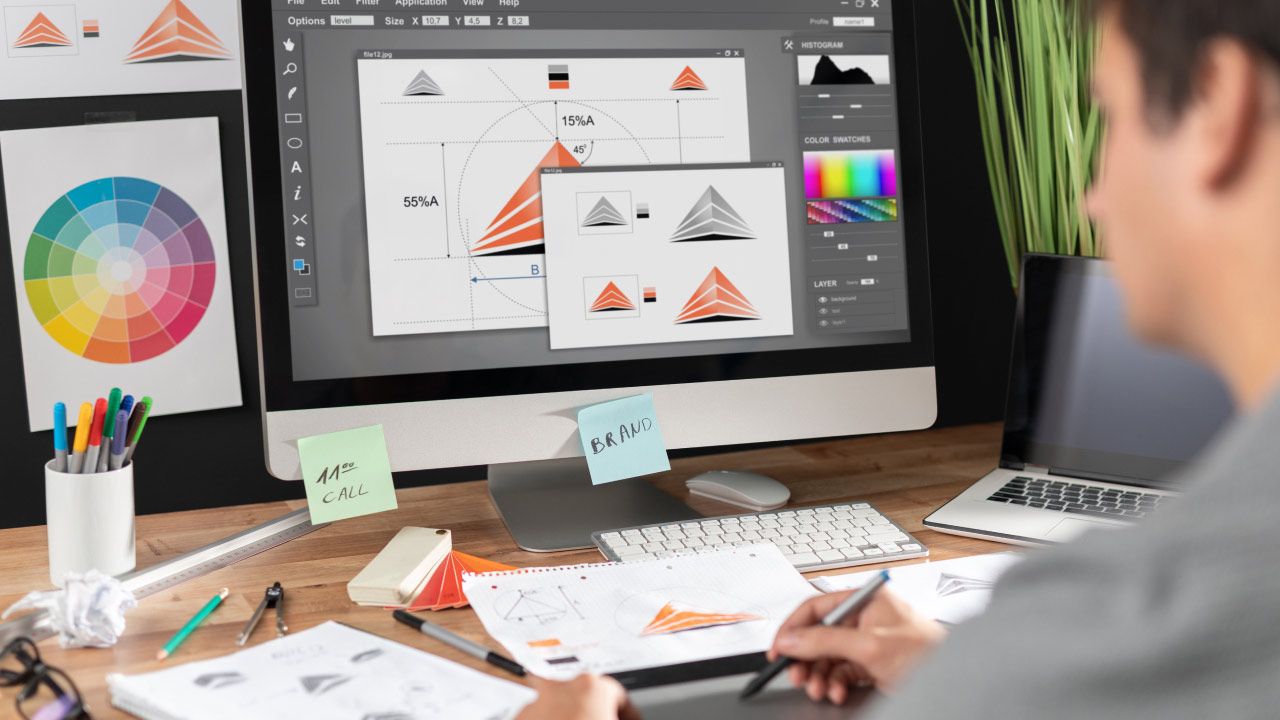Visual Designers vs. Graphic Designers: Who Does What And Why
By Marco Franzoni • May 3, 2024

Introduction: Understanding the Roles in Design
In the dynamic world of digital design, distinguishing between visual design and graphic design is not just a matter of semantics; it's essential for understanding the evolving roles and skills required in the design industry. As digital platforms continue to expand, the distinction between these design disciplines becomes crucial for both practitioners and employers.
Defining Visual and Graphic Design
Visual design and graphic design, though often used interchangeably, focus on different aspects of the design process. Visual design emphasizes the aesthetics and functionality of digital interfaces, from websites to mobile apps, involving a deep understanding of user interface (UI) and user experience (UX) principles. On the other hand, graphic design traditionally revolves around creating visual content for print and digital media, focusing on communication through typography, imagery, and color theory. While both fields require a keen eye for aesthetics, visual design leans more towards digital applications, making it a crucial skill in today's tech-driven environment.
Why Distinguish Between Visual Designers and Graphic Designers?
Understanding the distinct roles of visual designers and graphic designers is key to harnessing their strengths in a professional setting. Visual designers are often tasked with the job of refining user interfaces to enhance user interaction and engagement, requiring a blend of creative design and technical skills. Graphic designers, however, often focus on the visual communication aspects of a project, crafting branding materials and marketing communications that resonate on both an emotional and aesthetic level. By delineating these roles, companies can better align their design strategies with specific project needs, ultimately leading to more effective and targeted design outcomes.
This distinction not only clarifies hiring and team-building strategies but also helps aspiring designers carve out a career path that best fits their skills and interests, whether they are more inclined towards the technical aspects of digital design or the creative challenges of graphic design.
Visual Design vs. Graphic Design: The Blurred Line Between the Two Disciplines
As digital landscapes evolve, so too does the field of design, where the boundaries between visual design and graphic design are increasingly overlapping. Yet, understanding the core of each discipline is crucial for leveraging their unique strengths.
What is Visual Design?
Visual design focuses on the aesthetics and user interface of digital products. It is deeply intertwined with user experience, making it a critical component of how users interact with digital interfaces. Visual designers work to make websites, mobile apps, and other digital platforms not only more visually appealing but also more functional. They apply principles of design, color theory, and typography to enhance usability and ensure that every visual element feels intuitive and accessible.
What is Graphic Design?
Graphic design traditionally focuses on creating and combining symbols, images, and text to form visual representations of ideas and messages. Graphic designers might work on a variety of projects including print media, branding, advertising, and digital publications. Their work emphasizes visual communication design, aiming to convey specific messages effectively and attractively through a creative process that spans digital and print media.
Comparing Visual and Graphic Design
While visual design and graphic design share common tools and principles, their applications and focus areas differ significantly. Visual design is predominantly about enhancing user interaction with digital platforms through effective design elements and user interface strategies. In contrast, graphic design is more about communicating a message or a story through visual content, often in both digital and physical formats. This comparison not only highlights the specific roles of visual and graphic designers but also underscores the importance of choosing the right design focus to meet specific project or career objectives, emphasizing the blurred lines yet distinct paths each discipline follows.

Roles and Responsibilities
Understanding the distinct roles and responsibilities of visual and graphic designers is essential for both those entering the field and employers looking to hire the right talent for specific projects.
What Does a Visual Designer Do?
A visual designer focuses primarily on the digital realm, enhancing the user interface (UI) and overall user experience (UX) of digital products. Their responsibilities include crafting the visual aspects of websites, apps, and other digital interfaces to ensure they are both aesthetically pleasing and functionally intuitive. Visual designers often work closely with UX designers to create mockups and prototypes, employing design software like Adobe XD and Illustrator to bring their ideas to life. They need to have a solid grasp of design principles, color theory, and user research to effectively contribute to the design process.
Graphic Designer Roles & Responsibilities
Graphic designers, on the other hand, tend to have a broader scope that includes both digital and print media. Their job often involves creating visual content that communicates ideas or messages, designing everything from logos and marketing materials to print publications and digital ads. Graphic designers must be adept at using various design tools and platforms to produce work that captures attention and communicates effectively. They often collaborate with marketing teams and creative directors to ensure their designs align with brand and communication strategies.
Overlapping Duties and Distinct Tasks
While both visual and graphic designers share some common tools and techniques, such as design software and an understanding of color schemes, their specific duties can differ significantly. Visual designers are more focused on digital experiences and user interfaces, often requiring a strong technical background in web and mobile app design. Graphic designers, while also capable in the digital space, are more involved with creating and manipulating visual elements that may be used across a variety of media. The overlap between the two can sometimes be seen in areas like digital marketing, where both roles may contribute to the design of digital assets, yet their core responsibilities reflect their specialized training and focus.
Education and Skills
The foundation of a successful career in design, whether in visual or graphic fields, is built on a combination of formal education and a set of crucial skills that are refined over time through experience and ongoing learning.
Educational Requirements for Visual and Graphic Designers
Most employers expect visual and graphic designers to have at least a bachelor's degree in graphic design, visual communication, or a related field. This education provides a comprehensive understanding of design principles, color theory, and the use of design software, which are essential for both disciplines. Educational programs also often include portfolio projects that help students gain practical experience and showcase their capabilities to potential employers.
Skills & Qualifications Needed
Beyond formal education, designers need a robust set of essential skills. For both visual and graphic designers, these include creativity, attention to detail, and problem-solving capabilities. Proficiency in design software like Adobe Illustrator, Photoshop, and XD is crucial. Additionally, understanding user research, digital marketing, and the basics of web development can enhance a designer's skill set, especially in more digitally-focused roles.
Visual Design Skills vs. Graphic Design Skills
While there are overlapping skills between the two, certain abilities are more emphasized in one field over the other. Visual design skills often focus more on digital user interfaces and user experience elements, requiring a good grasp of UI/UX design principles and tools. Visual designers must be adept at creating functional yet aesthetically pleasing digital interfaces.
Graphic design skills, on the other hand, are broader, encompassing the creation of visual content that communicates messages across various media, from print to digital. Graphic designers need a strong understanding of print design, typography, and the production of physical media, which differentiates them from their visual design counterparts.
Both roles require ongoing learning and adaptation to keep up with the fast-paced changes in technology and design trends, ensuring that their skills remain relevant and their work impactful.

Job Descriptions and Career Paths
The fields of visual and graphic design offer a variety of career paths that cater to different skills and interests. Understanding the specific roles and potential career trajectories can help aspiring designers choose the right path.
Visual Designer Job Description
A visual designer focuses primarily on the look and feel of digital products. Responsibilities include crafting the user interface of websites, mobile apps, and other digital platforms. They ensure that these interfaces are not only visually appealing but also intuitive and user-friendly. Visual designers must be proficient in design software like Adobe XD and Photoshop, and have a strong understanding of user experience principles. Their role often requires them to collaborate closely with UX designers and developers to implement designs that enhance user interaction.
What Kind of Jobs Are There for Graphic Design?
Graphic design encompasses a broader range of media, including print and digital. Graphic designers can find jobs in advertising agencies, design studios, publishing houses, and marketing departments. Typical job titles include brand designer, art director, and creative director. These roles involve creating visual concepts that communicate ideas that inspire, inform, or captivate consumers, and may cover everything from designing logos and brochures to comprehensive branding projects.
First Up, The Difference Between a Web Designer and a Visual Designer
While both web designers and visual designers work on digital interfaces, web designers have a more technical focus, often needing skills in HTML, CSS, and sometimes JavaScript. They are primarily concerned with the functionality and structure of website pages, whereas visual designers are more focused on the aesthetic and experiential aspects, ensuring the design aligns with user experience goals.
Job Opportunities for Graphic Designers
The job market for graphic designers is vast and varied, covering both freelance opportunities and in-house positions. With digital marketing growing, graphic designers are increasingly needed to produce compelling digital content for social media, websites, and digital advertising campaigns. Additionally, as brands continually seek to differentiate themselves, the demand for innovative print design remains strong, ensuring a wealth of opportunities for those with a flair for visual communication and design aesthetics.
Salary and Market Demand
The financial rewards and market demand for design professionals can vary significantly based on factors such as experience, location, and the specific industry. Understanding these aspects can help both aspiring and established designers navigate their career paths more effectively.
How Much Money Do Visual Designers Make?
The salary of visual designers can vary widely, but generally, they are well-compensated due to their crucial role in the digital design process. Entry-level visual designers might start with a salary ranging from $50,000 to $65,000 annually, while more experienced designers, especially those in major tech hubs or senior positions, can earn $85,000 or more. Factors that influence a visual designer's salary include the complexity of projects they work on, their technical skills, and their ability to integrate user interface design seamlessly with user experience considerations.
Graphic Designer Salary
Graphic designers also see a range of salaries, largely dependent on their specific skill sets and the mediums they work with. On average, graphic designers earn between $45,000 and $60,000 annually, with variation based on whether they work in print, digital media, or both. Senior graphic designers or those with specialized skills in high-demand areas like digital marketing or branding can earn significantly more, potentially exceeding $75,000 per year.
Market Trends and Employment Projections
The demand for both visual and graphic designers remains strong, driven by the continual need for digital content and effective visual communication across all sectors. Digital design and marketing have seen particularly robust growth, increasing the need for designers who can operate effectively in digital spaces. Employment projections for the next decade suggest steady growth in design-related jobs, with particular expansions in sectors involving digital interfaces, user experience design, and visual marketing. Designers who keep pace with technological advancements and emerging digital platforms will find themselves well-positioned in an evolving job market.

Technical Skills: To Code or Not to Code?
In the evolving landscape of design, the integration of coding skills can significantly enhance a designer's versatility and marketability. Understanding the extent to which designers should possess coding abilities can help clarify career paths and training needs.
Do UI Designers Code?
UI designers often benefit from having basic coding skills, particularly in HTML, CSS, and sometimes JavaScript. These skills enable them to understand the technical possibilities and constraints of web design, allowing for more effective collaboration with developers. While not all UI design roles require coding, those who can implement their designs or at least prototype them tend to have a competitive edge in the job market.
Do Graphic Designers Code?
For graphic designers, coding is generally less essential but can still be beneficial, especially for those working in digital design. Knowing the basics of web development can help graphic designers understand how their designs are transformed into functional websites or digital products. However, their primary focus remains on visual communication and design elements, rather than on implementing or building digital interfaces.
The Growing Demand for Technical Skills in Design
The demand for designers who can bridge the gap between design and development is growing. As digital platforms become more complex and user experience becomes more central to digital strategy, designers with a robust set of technical skills—including coding—are increasingly sought after. This trend is pushing educational institutions and training programs to include more technical courses within design curricula, preparing the next generation of designers for the demands of a digital-first world.
Real-World Applications
The practical application of design principles in real-world scenarios is where visual and graphic design truly come to life. These applications are crucial for creating digital products that are not only visually appealing but also highly functional and user-friendly.
Examples of Visual Design Elements and Principles
Visual design relies heavily on elements such as color, typography, and layout to create cohesive and aesthetically pleasing interfaces. Principles of design like balance, contrast, and hierarchy guide how these elements are implemented. For example, effective use of color theory can guide a user’s attention to the most important parts of a website, while thoughtful typography can enhance readability and user engagement. These principles are applied in various digital projects, from web design to mobile app interfaces, ensuring that every visual element serves both aesthetic and functional purposes.
Create and Design Digital Products Using Canva
Platforms like Canva democratize design by providing tools that integrate essential design elements and principles into user-friendly interfaces. This allows both professional designers and novices to create digital products such as social media graphics, presentations, and marketing materials. By leveraging Canva, users can apply design principles without needing extensive training in graphic design, making design accessible to a broader audience and showcasing the practical applications of visual design in everyday digital content creation.
Enhanced Functionality and User Experience
The ultimate goal of applying design principles in digital products is to enhance functionality and improve user experience. This involves usability testing to ensure that designs are intuitive and meet the needs of the target audience. For instance, a well-designed user interface should facilitate easy navigation and minimize user frustration, thereby improving overall interaction with the digital product. The integration of usability testing in the design process helps identify potential issues before they affect the end-user, ensuring that the digital product not only looks good but also works seamlessly across various devices and platforms.

Conclusion: The Future of Design Roles
As we look toward the future of design roles, the lines between visual and graphic design will continue to blur, necessitating a more integrated approach to education and practice. Designers will increasingly need to harness a diverse set of skills that span both traditional graphic design and digital experience creation.
Integrating Visual and Graphic Design Skills
The integration of visual and graphic design skills is essential for creating compelling digital experiences that meet the evolving expectations of users. As digital platforms grow in complexity and reach, designers must be adept at using both visual and graphic design principles to create cohesive, engaging content that resonates across various media.
Preparing for a Dynamic Design Environment
To thrive in a dynamic design environment, designers must be proactive in learning new tools and technologies. Embracing the rapid changes in digital tools and user expectations will be crucial. Designers will need to remain flexible, continuously updating their skills to include new design methodologies and understanding how to leverage design as an effective tool for communication and interaction in the digital age.